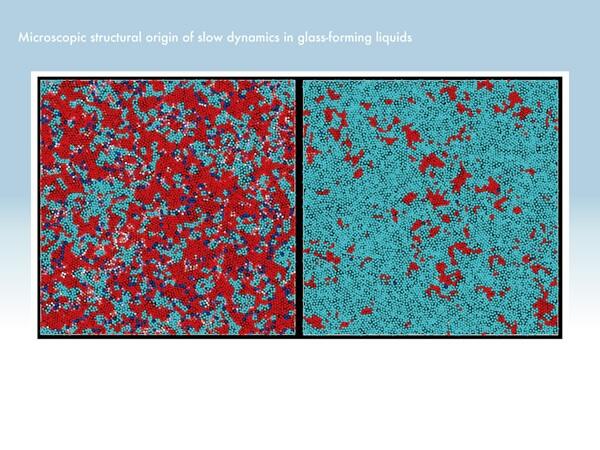Materials in the glass state are widely used in our surroundings—e.g., in window glass and transparent plastics—and humans have greatly benefited from using them since ancient times. However, unlike crystals, glass-state materials do not have a clear regular structure, and our understanding of their physical properties lags behind that of crystals. In particular, it is known that in the supercooled state, where a liquid is cooled to a temperature below its melting point, the movement of molecules and atoms becomes extremely slow as the temperature decreases. However, the physical mechanism underlying this phenomenon has long been a mystery.
A research group consisting of Senior Program Advisor Hajime Tanaka of the University of Tokyo's Research Center for Advanced Science and Technology (professor at the time of the research), Doctoral Student Seiichiro Ishino of the Graduate School of Engineering (at the time of the research), and Professor Yuanchao Hu of the Songshan Lake Materials Laboratory (JSPS Research Fellow at the Institute of Industrial Science at the time of the research) elucidated how the T1 process—a fundamental particle rearrangement mode—is related to the structural order and dynamic behavior of liquids at the microscopic level. They focused on the motion of individual particles and obtained results through numerical studies using a model of glass-forming liquids. The results were published in Nature Materials.

Provided by the Institute of Industrial Science, the University of Tokyo.
The research group performed numerical simulations focusing on the T1 process of a two-dimensional model of a vitrified liquid. The results revealed that whether or not the T1 process maintained the ordered structure in the liquid was an important factor in determining how rapidly the liquid slowed down (fragility). Nonfragile (strong) liquids such as silica follow the Arrhenius law and slow down gradually relative to fragile liquids. Meanwhile, fragile liquids slow down rapidly as the temperature decreases (showing super-Arrhenius behavior).
This study shows that when the T1 process disrupts the order of the local structure, no cooperativity appears in the motion and the dynamics show Arrhenius temperature dependence. Meanwhile, when the T1 process occurs in an ordered fashion, it is found to cascade from disordered to highly ordered regions. Furthermore, the coordinated movement leads to an increase in the effective activation energy, resulting in super-Arrhenius behavior. This discovery provides a new perspective on the structure-motion relationship of supercooled liquids, revealing the long-sought particle-level microscopic link between the growth of the liquid order, coordination of motion, and super-Arrhenius behavior. The findings are expected to provide a new perspective on controlling the dynamics of glass-forming materials and contribute to more efficient material design and improved glass production processes.
Tanaka commented, "It has been known for a long time that the dynamics of glass-forming liquids slow down rapidly as the glass transition temperature is approached. However, the underlying mechanism has long been a mystery. By focusing on the fundamental mode of particle rearrangement, we were able to partially solve the mystery regarding how the order formed in liquids causes slow dynamics. We hope that this discovery will lead to the clarification of a long-standing mystery about the slow dynamics exhibited by glass-forming materials."
Journal Information
Publication: Nature Materials
Title: Microscopic structural origin of slow dynamics in glass-forming liquids
DOI: 10.1038/s41563-024-02068-8
This article has been translated by JST with permission from The Science News Ltd. (https://sci-news.co.jp/). Unauthorized reproduction of the article and photographs is prohibited.




